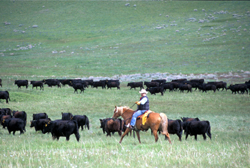Cattle
Updated: September 14, 2020

Agriculture is an essential part of Montana's economy. Of the livestock portion, cattle make up the largest fraction. In fact, there are 2.6 million head of beef cattle in Montana. That means there are about three head of cattle for every human in the state of Montana. This makes Montana sixth in the United States for total number of beef cattle.
Montana also has 18,000 dairy cows, and on average each cow produces 16,833 pounds of milk per year. Dairy cows produce milk, which is very important, and milk can be made into other products like ice cream or cheese. Dairy farmers in this state produce enough milk to fill a football field 314 feet deep every year. That's a lot of milk!
Montana is also known as the seedstock capital of the world. Seedstock means registered cattle used for breeding. Other than meat and milk, cows provide us with other important by-products. Some edible examples include oleomargarine, gelatin and marshmallows. Those we cannot eat are things like leather, soap, cosmetics and buttons. Cattle also contribute to the health industry. Humans use medicines made from cattle by-products such as insulin, estrogen and thyroid extract.
Cattle are ruminants, which means they have one stomach with four separate compartments. They have a digestive system that allows them to digest plant material by repeatedly regurgitating it and chewing it again as cud. This digestive process allows cattle to thrive on grasses, other vegetation, and feed.

Many ranchers run cow-calf operations. They keep a herd of cows to produce calves. Cows are pregnant for nine months (just like humans!). In Montana they have their calf in January, February or March. The calves stay with the cow until October when they are sold. In some other states, cows have their babies in the summer and the calves go to market in early spring the next year.
There are many different breeds of cattle. The first cattle were brought to the United States by Spanish conquistadors in the 16th century. Other cattle came mainly from England, France, Switzerland and India. Some types, or breeds, are Angus, Limousin, Simmental, Hereford, Charolais and Shorthorn. Breeds like Angus or Hereford are well suited to Montana. They have thicker hair coats and can adapt to the cold winters.
Updated: September 14, 2020

